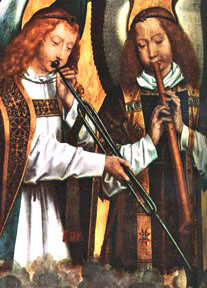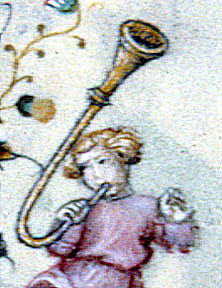The medieval trumpet, or buisine, was typically straight and therefore somewhat unwieldy. It was probably used just for military calls and drones.
Shawms and slide trumpet. Gothic Winds. Les Haulz et les Bas. Christophorus CHR 77193 (1996). Trk 17 Qui latuit.
Starting around 1400, U-bends, S-curves, and then folding allowed lengthening and more convenient handling of the trumpet. Soon after that, the instrument spawned the slide trumpet, which allowed the variable lengthening of the instrument (and thus the playing of more pitches) by means of a single slide.
By the mid-15th century, the slide trumpet evolved into the double-slided trombone or sackbut. The slide trumpet and later the sackbut found a place in the shawm band, playing dances and ceremonial music especially.

Shawm & slide trumpet. Angel musician (detail) from the Najera Tryptich by Hans Memling (ca.1480). Antwerp, Musée des Beaux-Arts, no. 779.




